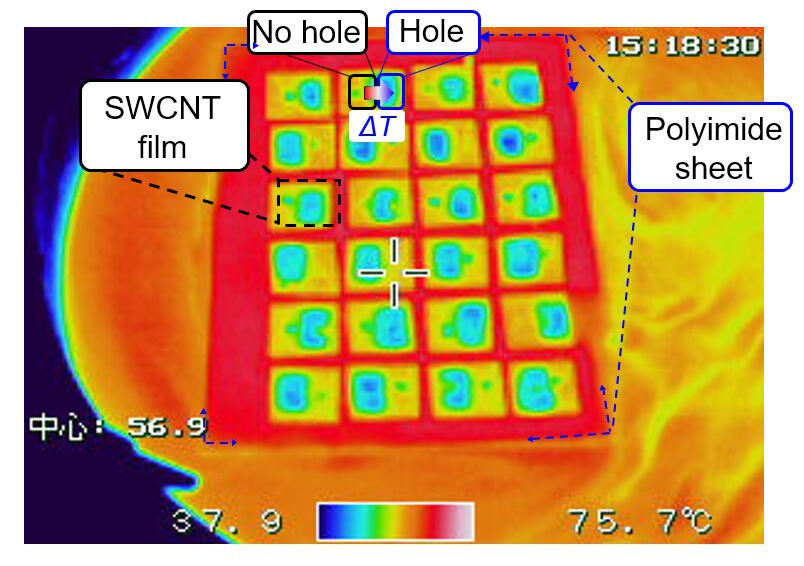Professor Masayuki Takashiri's research group at the Tokai University School of Engineering, Department of Materials Science has succeeded in developing a carbon nanotube (CNT) thermoelectric generator that does not require a heat source; this was achieved by simply floating the device on the surface of water utilizing a single-walled CNT thin film.
A thermoelectric power generation device is one that converts thermal energy into electrical energy, and extracts voltage and power from the temperature difference generated in the thermoelectric material. Professor Takashiri said, "When we were observing the CNT film with an electron micrograph, we observed that there were innumerable gaps, and as we were wondering if we could leverage these gaps, we thought up this device. The light weight, flexibility, and excellent light absorption of CNTs additionally benefit the device."
In the production of these CNT power generation devices, a flexible polyimide substrate (length 80 mm, width 60 mm, thickness 125 µm) was utilized, and holes were drilled alternately in a houndstooth pattern. When the CNT film and substrate were adhered, the parts that could and could not pump water via capillary action were obtained by separating the substrate between the water surface and CNT film.
When this power generation device was made to float on the water surface, a cooled section was formed in each CNT film, and the research group succeeded in creating a temperature difference in opposite directions between adjacent elements of the device. The thermal conductivity of the obtained CNT film was 5.4 and 9.0 × 10-3 W/m · K in the in-plane and cross-plane directions, respectively, with respect to the film. These values are lower than the thermal conductivity of the existing CNT film, indicating that the temperature gradient in the film can be effectively generate Each CNT film was also connected to a thin copper wire to evaluate the device performance.
To measure the output characteristics of the power generation device, the research group set the conditions of water temperature to 20 ℃ and 70℃, wind speed to no wind and 3 m/s, and light irradiation to no simulated sunlight irradiation, and 1 kW per square meter. Under the standard environmental conditions (water temperature 20℃, no wind, no light-based irradiation), a temperature of 2K was generated in one CNT film, and an output voltage of approximately 0.5 mV and power of approximately 1.5 nW were obtained for the entire device. The measurement time was 60 min, during which the output was maintained at an approximately constant level.
The highest performance was obtained at a water temperature of 70 ℃, a wind speed of 3 m/s, and a light irradiation of 1 kW per square meter, an output voltage of approximately 15 mV, and a maximum power of 1.3 µW. Professor Takashiri stated, "The developed device can serve as the basis for developing an independent power source in an environment without a heat source, such as several wireless monitoring systems for water quality and water volume management. Furthermore, we intend to increase the output characteristics by optimizing the device structure. In the future, this may lead to power generation devices that utilize human perspiration meaning that it can be considered as a power source for wearable sensors as well."

Credit: Tokai University
This article has been translated by JST with permission from The Science News Ltd.(https://sci-news.co.jp/). Unauthorized reproduction of the article and photographs is prohibited.




